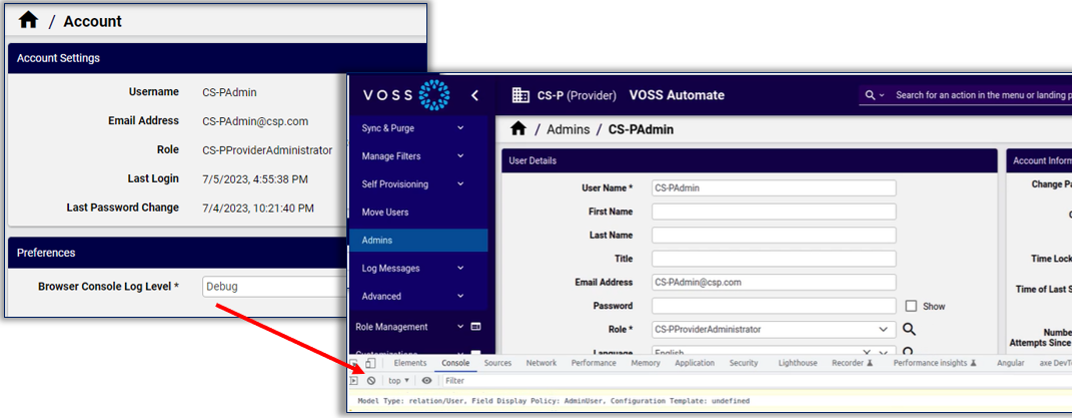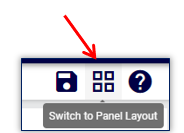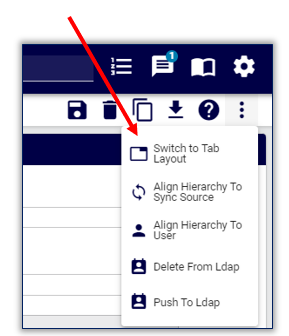Introduction to the Admin Portal User Interface#
Tutorial: videocam
If you found this video helpful, you can find more at Tutorials Home.
Overview#
This topic is a guide to the VOSS Automate Admin Portal user interface.
Tip
To easily copy data from a drop-down list or in a list view (provided you’re using a mouse), highlight the value while keeping the mouse button pressed down and use the keyboard shortcut CTRL-C to copy, then release the mouse and paste the data where required.

Related Topics
Admin Portal Toolbars#
In the VOSS Automate Admin Portal, icons on the main toolbar are always available, regardless of the form or list you’re viewing.
A form/list-based toolbar displays additional icons, depending on the model you’re working with (which defines the content on the form or list you’re viewing), and on your access profile and permissions. For example, if it’s not possible or allowed that you move certain items, the Move icon won’t display.
Main Toolbar#
The table describes the graphical controls and icons on the main Admin Portal toolbar:

The table describes the icons on the main toolbar in the Admin Portal:
|
Launches a hierarchy (organization) tree view that displays a tree or list of available nodes. See Navigating the Hierarchy Note that the accent color is used for this element. |
|
A hierarchy element displaying the highest hierarchy level. The associated child hierarchy element display in a similar field display box adjacent to the main hierarchy element. If there is more than one level or node at a specific hierarchy, you can search and navigate the hierarchy. See Navigating the Hierarchy. |
|
Search bar. Fill out search criteria to use the default search (Action search), or click the down arrow at the filter icon to choose an alternative search mode:
|
|
Opens the transactions list, where you can view a list of in progress and recent completed transactions, and drill-down to view transaction details. The pulsing counter above the icon indicates the number of transactions currently in progress. The spinner adjacent to the icon indicates that your transactions are in progress. |
|
A notification indicator and menu for accessing the Transaction log and Alerts (if alerts are enabled). A pop-up notification displays when a transaction is done. You can click on the message to inspect transactions. Alert notifications display until all alerts are removed from the list. |
|
Opens Wingman Chat if enabled. Refer to VOSS Wingman. |
|
Opens the system online Help in a new browser tab. |
|
Provides a menu with items for:
|
|
A Home navigation button to return to a customizable dashboard that serves as a landing page. See “Automate Dashboards” for details.
|
Note
To view details for:
the model
field display policy
configuration template
fixed filters
applied to any page in the GUI, in Account > Preferences set Browser Console Log Level to Debug, and
save your changes. Then open the page where you want to view these details, right click, and choose Inspect to open
the browser console.

Forms and Lists Toolbar#
For certain models, such as Roles or Credential Policy, the list view or detail view of the record in the Admin Portal displays an additional toolbar with a number of controls.
The icons that display on this secondary toolbar depend on your access profile and based on the functionality available for data on the form or list (the model you’re working with).
Standard Icons
The table describes standard icons that typically display on all forms and lists.
Icon |
Description |
|---|---|
Filter |
Allows you to filter items on a list. |
Plus icon (+) |
Creates a new record from a list view. |
Delete |
From a list, remove an entry or the selected entries. |
Move |
You can move some model instances (by default, device models) from the current hierarchy to another hierarchy. When moving device models, the system won’t allow you to move a device model instance to a hierarchy node with a different device. For data models, move is allowed if you edit the data model’s definition in the Operations section. |
Clone |
Make a copy of the current item, and rename it to create a new instance. |
Export |
From search results or any list view in the system, it is possible to select the entities required and export them with all attributes. The selected data can be exported to:
|
Save |
Saves a new or updated record. |
Cancel |
Cancels triggered events such as transactions or bulk loads. |
Back |
On forms, this icon returns to the original list page position. The browser’s back button also carries out this action. |
Help |
Open the on-line help page for the current model. |
Overflow Actions Menu
On forms and lists that allow multiple actions, icons for key actions (for example, Filter, Add, Create, Update, Delete), are always visible on the toolbar,
whereas other available actions are accessible via a vertical ellipsis toolbar icon (![]() ), which displays a drop-down menu of the additional (overflow)
actions available for data on the form or list.
), which displays a drop-down menu of the additional (overflow)
actions available for data on the form or list.
The image shows non-key actions available in the overflow menu when viewing or updating a user, for example:

Note
Accessibility support is provided for the overflow actions menu so that you can tab through the actions and press Enter or space bar to select an action in the menu.
The table lists actions that may be available in an overflow actions menu on a form or list, if relevant for the record and allowed for your access profile:
Action |
Description |
|---|---|
Bulk Load File |
Only used in Administration Tools > Bulk Load, when bulk loading a preselected file. |
Bulk Modify |
On the list view of certain items, the button displays a form to enter modifications to any selected list items and carries out a Bulk Modify. This is only available if your administrator has given you. the required permissions. |
Configuration Template |
For a form, create a Configuration Template for a model or carry out a task such as an advanced search. |
Action |
Description |
|---|---|
Export Bulk Load Template |
Export a model structure to a MS Excel bulk load file format. The file can be used as a template to bulk load instances of the model. Refer to the Bulk Load topic help. |
Field Display Policy |
Add a Field Display policy to a selected model. The detail view of a Transaction displays this button to show sub-transactions. |
Execute |
For an executable model such as a Provisioning Workflow, Macro, Wizard or for a script, run the execution. |
Import |
For supported Network Devices, carry out an import of data from the device. |
Package |
Create a package containing selected search results. |
Refresh |
Click this button on the Transaction list to refresh the list of transactions. This would for example update the Progress of the transaction. |
Refresh User |
On the User Management page, click Refresh User to align user data in relation/User with user data from source, caching from the UC application. This option is not exposed by default in the access profiles. |
Replay |
Transactions that have failed can, under certain circumstances, be replayed. This means that the transaction is re-submitted with the original request parameters. |
Edit and Replay |
Available for completed transactions. Similar to the Replay button, but allows you to first make changes to the previously submitted form before the transaction is resubmitted. |
Reset Phone |
Reset a phone. |
Return |
Return - From the detail display of a selected instance of a model, select this button to return to the list display of the model instances. |
Tag |
For a selected model instance, add a tag to it. |
Tag Version |
For a selected model instance, add a version tag to it. |
Test Connection |
For instances of models representing connection parameters such as connections to devices, click the button to test the connection. |
Visualize |
Deprecated. |
Purge |
Removes a record entirely. |
JSON Editor |
Update a JSON file. |
Apply |
Saves and updates the record. |
Lock |
Disables editing. |
Reset |
Clears the record. |
Restart |
|
Vendor Config |
|
Wipe |
Forms and Lists#
The Admin Portal displays information in forms and lists.
Detail forms: during input, mandatory fields are highlighted in a red frame.
List views of details. If the text in a column exceeds the defined column width, it is truncated with an ellipsis (…), except for any column showing the row entry hierarchy.
Form Controls#
The following controls are typically available on forms.
Icon |
Description |
|---|---|
|
Open another instance of the current form field or open a pop-up screen to add an item. |
|
Delete the current instance of a field from a form or open a pop-up screen to confirm. |
|
Move the selected instance on a form down in the order of field entries. In the case where a Position field is available, for example for Lines, the entered value determines the order in the object. |
|
Move the selected instance on a form up in the order of field entries. In the case where a Position field is available, for example for Lines, the entered value determines the order in the object. |
|
Collapse or expand all array items, for form arrays with multiple items. Arrays are collapsed by default. You can expand or collapse selected array items in a form array, or expand/collapse all from the form array header. |
Icon |
Description |
|---|---|
|
On multi-tabbed forms, navigate to the previous or next tab. |
|
A warning icon, for example if a mandatory field is not filled in. |
* |
Next to an input control on a form, the asterisk indicates that the field is mandatory. |
[Browse] |
Next to an input control on a form, a button to open a file selection dialog. |
[ V] |
Drop-down input box. Typing into the box filters the drop-down list choices. |
Note
On some parts of the user interface, when adding or deleting items via pop-up screens, clicking the OK button typically completes the update; that is, you won’t need to also click Save on the main form.
Switching Form Layouts#
The layout of forms in VOSS Automate is defined via a number of field display policies (FDPs). For groups of fields, the default layout for the field display policies setting, Display Groups As, is Panels, except for the forms associated with the following models, which have their default layout as Tabs:
view/GlobalSettings
data/SiteDefaultsDoc
data/ucprep_UC_Profiles
relation/DP_REL
data/HcsDpDialPlanSchemaDAT
data/HcsDpDialPlanSchemaGroupDAT
On forms where you’re able to change the layout (depending on your user type and the model type), you can click the layout change icon (Switch to Panel Layout / Switch to Tab Layout) to switch between a tab layout and a panel layout. The layout you choose is preserved when you log out and log in again.

On some forms, the action element to use for switching between tabs and panels may display in the overflow actions menu.

The animation shows how you can switch between a tab and a panel layout on the Users page.

Note
This guide refers to the default layout for the model, unless otherwise specified.
Some form views do not have the action element available to switch between tabs and panel form views. For details and the list, see the “Display Groups As” topic at: Field Display Policies.
Related Topics
Slide out notifications#
A Cached slide-out notification at the top right of the interface displays when the locally cached data of a resource is used.
This slide-out notification can be minimized to a narrow bar on the side of the screen.
Accessibility#
To support accessibility, when using keyboard navigation, a black bar is enabled above the toolbar. When the cursor is in the URL box and the Tab key is pressed, this bar is displayed and has three menu items corresponding to three areas of the main user interface:
Home screen |
From any form on the interface, return to the main user interface. This is equivalent to the Home button on the main toolbar, and can, for example be accessed by means of a screen reader shortcut. |
Skip to content |
On the main user interface, move the focus to the dashboard menu items. Press <Tab> to move the focus to the first dashboard link. |
Skip to navigation |
On the main user interface, move the focus to the menu bar. The first menu item receives focus. |
Sessions and Authentication#
Since VOSS Automate sessions are cookie based, it is possible to share the same session across different tabs or windows of the same browser. However, it is not possible to have different authentication sessions in different tabs. In other words, login as different users in different browser tabs is not supported.
On-line Help#
To access the full online help website from the Automate Admin Portal, press the toolbar Book icon. To access help for a page you’ve viewing in the system, click the Help icon.
The page-level (context) help also includes a Full HTML Help link for the entry on the online help website and the model help (as seen in the GUI tooltips).
Note
In order to have access to the online help website URL, you may need to request that the website be made accessible by your network administrator.
Your view of the system help depends on your hierarchy level, role-based access permissions, and the field display policies applied to your system.
About (System details)#
The About menu provides details for your system, including version, patches, and adaptations.
Note
The About toolbar icon provides only version details.
Version#
Release: Installed product release version.
The version naming convention is:
new: <YY>.<num>, for example: 19.3 is the 3rd release of 2019.
legacy: <major>.<minor>.<revision>, where major=YY,minor=num,revision=revision of num.
Patch Bundle: The installed Patch Bundle (PB) number, if any.
Build Number: Product build number.
Release Date: Date when this version was released.
Deployed Mode: Current deployment mode type, for example:
Provider
Enterprise
Note
You can use the toolbar Copy icon to copy version release text to the clipboard.
Patches#
If any patches have been installed on the system, these are listed under the Patches menu. Details of installed patches are also provided for reference and enquiries, for example:
Version: in this context, the patch version (there can be multiple versions of the same patch).
Defect IDs: VOSS Automate internal IDs for reference
Models: any models and model Instances added or affected by the patch
Adaptations#
If any adaptations are installed on the system, these are listed. Select an adaptation from the list to see more details, for example:
Adaptation Tag(s): the tags can be used to find all models that are a part of the adaptation, using a search query such as
(tag IS <tag1>) or (tag IS <tag2>)
where
<tag1>and<tag2>are the names of tags.Note
The search for models is carried out from the user hierarchy and down.
Upgrade Risk: an indication of the impact of an adaptation on an existing system:
High: Core changes
Medium: Standalone adaptation using core workflows
Low: Standalone feature
License#
This menu provides details for your current license, including the platform UUID, license status, and expiry date. See also, Product License Management.
License Counts#
This menu provides details of overall license counts following daily license audits. For details, see the Licensing and Subscriber Data Export Guide.


